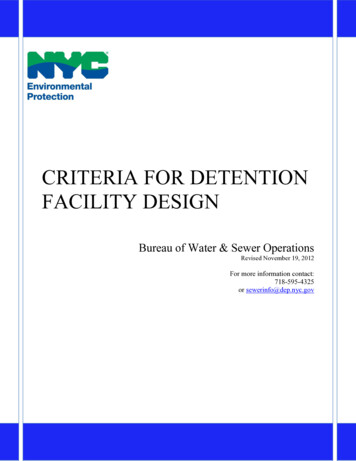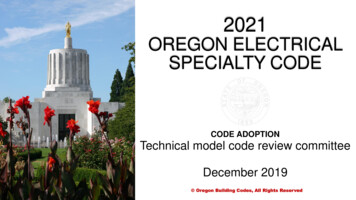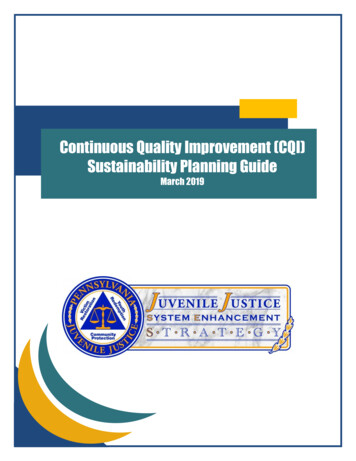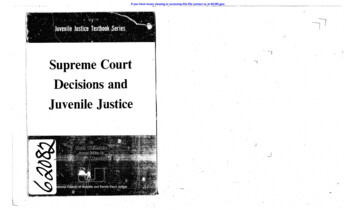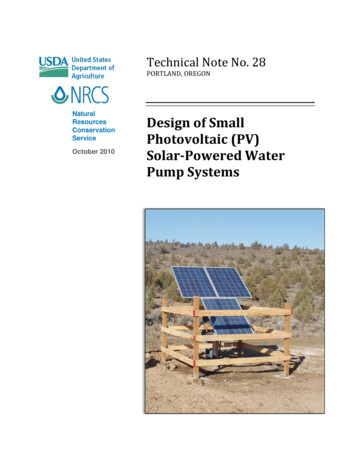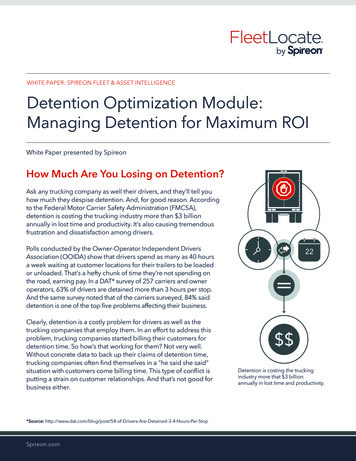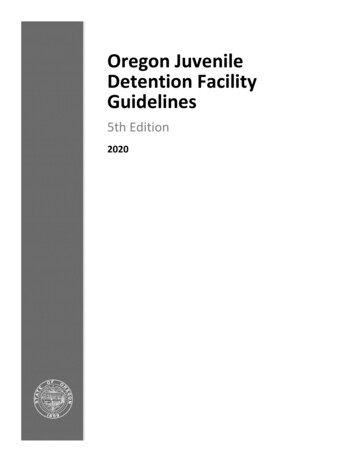
Transcription
Oregon JuvenileDetention FacilityGuidelines5th Edition2020
Oregon Juvenile Detention Facility GuidelinesTable of ContentsYouth Development Division and Oregon Department of Corrections. 5Introduction . 5Foreword . 7Purpose . 7Background . 7Effective Date. 8Format of Revised Guidelines . 8SECTION 1: GENERAL ADMINISTRATION . 91.1 Purpose and Mission . 91.2 Mandatory Juvenile Detention Statutes . 101.3 Administration . 131.4 Inspections/Reviews . 13SECTION 2: INTAKE, ADMISSION AND RELEASE . 152.1 Intake Decisions . 152.2 Admissions . 192.3 Notice of detention hearing. 202.4 Personal Property . 212.5 Orientation. 212.6 Detention Review Hearing . 222.7 Time Limitations. 232.8 Extended Detention . 232.9 Interstate Compact for Juveniles . 242.10 Release . 24SECTION 3: SECURITY AND CONTROL . 253.1 Safety and Security . 253.2 Searches . 263.3 Supervision of Youth . 283.4 Control of Contraband . 283.5 Use of Force . 293.6 Use of Restraints . 311
Oregon Juvenile Detention Facility Guidelines3.7 Room-lock . 333.8 Isolation . 353.9 Emergency Evacuation and Management . 35SECTION 4: PROGRAMS AND SERVICES . 364.1 Mental Health Services (Counseling) . 364.2 Education in Juvenile Detention . 364.3 Extended Detention Programs. 394.4 Recreation and Physical Exercise . 394.5 Library Services . 404.6 Mail, Telephone, Visitation . 41SECTION 5: YOUTH RIGHTS . 435.1 Protection from Harm . 435.2 Access to Courts, Counsel, and Governing Authorities. 455.3 Access to Records and Legal Materials . 465.4 Juveniles with Disabilities . 475.5 Dress, Grooming, and Personal Hygiene . 475.6 Freedom of Religious Expression . 485.7 Grievance Procedures . 49SECTION 6: BEHAVIOR MANAGEMENT SYSTEM . 50Best Practices . 516.1. Rules of Conduct . 516.2 Accountability . 52SECTION 7: PERSONNEL . 547.1 Staffing . 547.2 Drug-Free Workplace . 567.3 Training and Staff Development . 56SECTION 8: RECORDS AND INFORMATION SYSTEMS . 618.1 Youth Records . 618.2 Information Systems . 618.3 Release of Information . 62SECTION 9: HEALTH CARE . 642
Oregon Juvenile Detention Facility Guidelines9.1 Access to Care . 649.2 Mental Health Services . 669.3 Pharmaceuticals . 689.4 Medical and Dental Services . 699.5 First Aid . 709.6 Infectious Disease . 719.7 Informed Consent . 719.8 Health Records . 71SECTION 10: FOOD SERVICES . 7210.1 Meals, Nutrition, and Special Diets. 7210.2 Food Health and Safety. 72SECTION 11: PHYSICAL PLANT . 7311.1 Building and Fire Codes. 7311.2 Rated Capacity . 7411.3 Location. 7411.4 Sleeping Rooms and Dayrooms . 7511.5 Housing for Youth with Physical Disabilities . 7611.6 Classrooms and Activity Space. 7711.7 Environment - Positive Facility Atmosphere. 77SECTION 12: DATA AND EVALUATION . 78APPENDIX A . 79Definitions . 79APPENDIX B . 85JUVENILE JUSTICE AND DELINQUENCY PREVENTION ACT SUMMARY . 85APPENDIX C . 87VALID COURT ORDER – STATUTORY EXCEPTION . 87APPENDIX D. 89PROCEDURE REGARDING NATIVE AMERICAN CEREMONIAL ITEMS AND CEREMONIES WITHIN A COUNTYJUVENILE FACILITY . 89APPENDIX E . 90MEMORANDUM OF UNDERSTANDING . 903
Oregon Juvenile Detention Facility GuidelinesEXHIBIT A . 94ROLES AND RESPONSIBILITIES . 94EXHIBIT B . 99SPECIAL REQUIREMENTS . 99APPENDIX F . 100PREA Self-Disclosure and Acknowledgment Form. 1004
Oregon Juvenile Detention Facility GuidelinesYouth Development Division and Oregon Department of CorrectionsWith assistance from:Basic Rights OregonDisability Rights OregonNative American Advisory CommitteeOffice of Legislative Policy and ResearchOffice of the GovernorOregon Department of EducationOregon Judicial DepartmentOregon Juvenile Department Directors’ AssociationOregon Youth AuthorityYouth Development CouncilYouth, Rights and JusticeIntroductionWithin the Oregon juvenile justice system, juvenile detention facility is a locally resourcedentity that provides secure placement for youth pursuant to Oregon Revised Statutes.There are twelve juvenile detention centers in Oregon, operated locally, and three outside ofOregon accessed by adjacent Oregon counties. The Northern Oregon Correctional Facility(NORCOR) is the only juvenile detention facility in Oregon created through a Chapter 190Intergovernmental Agreement. The operation of each juvenile detention facility is theresponsibility of the county juvenile department and the governing entity, except that the 190intergovernmental entity is governed by a Juvenile Detention Oversight Committeerepresenting the member counties (Gilliam, Hood River, Sherman and Wasco).The following is a list of the juvenile detention centers in Oregon and their currently fundedoperating capacity. Several of the facilities have the capacity to expand and constrict based onneeds and funding.5
Oregon Juvenile Detention Facility GuidelinesCountyDeschutes CountyDouglas CountyJackson CountyJosephine CountyKlamath CountyLane CountyLincoln CountyLinn – BentonMarion CountyMultnomah CountyNORCORYamhill CountyTotalCapacity16 beds32 beds24 beds14 beds16 beds16 beds8 beds20 beds32 beds64 beds32 beds24 beds298 bedsLocationBendRoseburgMedfordGrants PassKlamath FallsEugeneNewportAlbanySalemPortlandThe DallesMcMinnville6
Oregon Juvenile Detention Facility GuidelinesForewordPurposeThese guidelines pertain to the general operation of juvenile detention facilities in the State ofOregon. They are binding if identified as statutory, federally mandated, or established byadministrative rule or other regulation. The guidelines are required by Oregon Revised Statute(ORS) 169.090 (2) which states that the Youth Development Council and the OregonDepartment of Corrections are to develop and, when appropriate, revise the guidelines.Each section of these guidelines includes both the mandatory statutes and regulations, and isfollowed with a section outlining best practices with juvenile justice. These guidelines aredesigned to provide juvenile detention facilities the framework to measure the operations andfacilities with others in Oregon and nationally. These recommendations support and ifimplemented assist juvenile detention facilities in meeting and exceeding the mandatorystatutes and regulations.These guidelines do not constitute a comprehensive source of all youth rights or facility’sobligations to these rights under state and federal law, administrative regulations, and the U.S.Constitution. The “best practices” may be grounded in legal rights that are not explicitlyaddressed by the Oregon statutes referenced in the document.For the purpose of these guidelines, a juvenile detention facility is a facility for the securecustody of youth accused or convicted acts which would constitute crimes if committed byadults, or for youth held pursuant to judicial orders or commitments under the provisions ofOregon law (ORS 419A.004, ORS419A.010, ORS419A.050 to ORS419A.063 and ORS420.855).“Child serving systems should commit to core principles to ensure an evidence-based andtrauma informed response.” (Disability Rights Oregon Report, 2017, Recommendation #4).In some instances, statute requires written policy. It will be stated explicitly in the guidelinesbelow when that is the case. The intention of these guidelines, however, extends theexpectation of a written policy for all of the guidelines without directing what that policy mustbe, except when legally mandated.When developing written policy and procedures, a juvenile detention facility should do so in amanner that respects and values diverse life experiences and ensures that all youth are valuedand heard, taking into consideration all people’s gender identity, race, ethnicity, national origin,age, sexual orientation, religious believes, family status, education, and/or disability to establishan inclusive environment, and equitable treatment of all.BackgroundThe guidelines were first adopted in 1982, and revised in 1984 (2nd Edition) and 2001 (3rdEdition) 2012 (4th Edition). The Youth Development Division initiated the current update to the7
Oregon Juvenile Detention Facility Guidelinesguidelines. They reviewed the guidelines and solicited feedback from key stakeholders (OregonDepartment of Corrections, Oregon Juvenile Department Directors’ Association, Office ofGovernor Kate Brown, Oregon Department of Education, Oregon Youth Authority, and others)including advocacy organizations to modify and formalize the revisions. The revised guidelineswere reviewed and approved by the Director of the Oregon Department of Corrections,Director of the Youth Development Division, and the Youth Development Council.Effective DateThe 5th Edition became effective March 19, 2020.Format of Revised GuidelinesThese guidelines incorporate Oregon Revised Statutes (ORS), and other federal and stateregulations and requirements and best practices from the American Correctional Association –Juvenile Detention Facilities, National Partnership for Juvenile Services, National DetentionAssociation, Juvenile Detention Alternatives Initiative – Conditions of Confinement SelfAssessment. ORS references are in bold and link to each respective reference. To accommodatechanges in statute and administrative rules, statutory provisions are either paraphrased orreferenced. Questions about specific language should be answered by referring to the mostrecent statute, administrative rule or regulation. These guidelines should be used withcomprehensive written policies that ORS 169.760 requires for each juvenile detention facility.This format is intended to provide a uniform framework for organization of local policies.For questions, please contact Juvenile.Detention.Guidelines.Help@state.or.us8
Oregon Juvenile Detention Facility GuidelinesSECTION 1: GENERAL ADMINISTRATION1.1 Purpose and MissionThe purposes of the Oregon juvenile justice system beginning with apprehension are to protectthe public, to reduce juvenile delinquency, and to provide fair and impartial procedures for theinitiation, adjudication and disposition of allegations of delinquent conduct. The system isfounded on principles of personal responsibility, accountability and reformation within acontext of public safety and restitution to victims and to the community. As required by ORS419C.001, the system shall provide a continuum of services that emphasize prevention offurther criminal activity by the use of early and certain sanctions, reformation andrehabilitation programs and swift and decisive intervention in delinquent behavior, and thesystem shall be open and accountable to the people of Oregon and their electedrepresentatives.Juvenile detention facilities provide secure placement for public safety, ensure courtappearance, and reintegration services for youth accused of acts which if committed by adultsas defined in ORS 419C.145(2). Youth can also be held pursuant to judicial order orcommitment, and which are established under the provisions of Oregon law. (ORS 419A.004,ORS419A.010, ORS419.050 to AORS419A.063 and ORS420.855) Children or youth charged withoffenses that would not be crimes if committed by adults shall not be held in a detentionfacility, unless permitted by state law.“Juvenile detention facility” means a facility as described in ORS 419A.050 – Authority toacquire, equip and maintain detention and shelter facilities and 419A.052 – Specifications offacilities.In addition to maintaining public safety, juvenile detention facilities are used for skilldevelopment, K-12 education, rehabilitation, addressing treatment needs and facilitating thesuccessful reintegration of youth into the community. County detention facilities should committo core principles to ensure best practices and services. Juvenile detention facilities shouldintegrate culturally-sensitive, gender-responsive, trauma-informed and developmentallyappropriate approaches into policy, programming and practices. All detention facilities shouldbe committed to implementing best practices that teach life skills and incentivize pro-socialbehavior in an effort to develop the tools needed for youth to re-enter and thrive in thecommunity.9
Oregon Juvenile Detention Facility GuidelinesAuthority to acquire, equip and maintain detention facilities (ORS 419A.050)Each county has the statutory authority to acquire, equip and maintain detention facilities. TheOregon Department of Education has the statutory authority to provide the K-12 educationalservices. Statute clearly states the specifications of facilities, examination process of facilities,capacity limits and standards for release.The juvenile court of each county shall designate the place or places in which youths are to beplaced in detention when taken into temporary custody. If the county is adjacent to anotherstate, the court may designate a place or places in the adjoining state where children, wards,youths or youth offenders, pursuant to an agreement between such place or places and thejuvenile department of the county, may be placed in detention or shelter care when taken intocustody.“County” as referenced in these guidelines and ORS is the entity operating under the guidelinesand authority granted by ORS Chapter 203.Inspection of juvenile detention facilities and enforcement of the juvenile detention standardscontained in ORS 419A.059 or otherwise established by statute, must be conducted in the samemanner as provided in ORS 169.070 and 169.080.These guidelines do not apply to law enforcement facilities in which youth may be temporarilydetained pursuant to ORS 419C.080 – Custody when authorized.1.2 Mandatory Juvenile Detention Statutes1.2. A Detention and Shelter FacilitiesORS 169.076 Standards for local correctional facilitiesORS 169.077 Standards for lockup facilitiesORS 169.078 Standards for temporary hold facilities1.2. B Enforcement of Standards for Local Correctional and Juvenile DetentionFacilitiesORS 169.080 Effect of failure to comply with standards; enforcement by Attorney General;private actionORS 169.085 Submission of construction or renovation plans to Department of Corrections;recommendations by department1.2. C Treatment of PrisonersORS 169.105 Unconscious person not to be admitted to custody in facility10
Oregon Juvenile Detention Facility GuidelinesORS 169.140 Furnishing prisoners’ food and clothing1.2. D Juvenile detention facilitiesORS 169.730 DEFINITIONS FOR ORS 169.740 TO 169.760ORS 169.740 Standards for juvenile detention facilitiesORS 169.750 Restrictions on operation of juvenile detention facilitiesORS 169.760 Juvenile detention facilities to establish written policyORS 169.770 Release of detained juvenile when detention facility violates standardsORS 169.800 Detention of juveniles before conviction and execution of sentencingORS 169.810 Assumption of duties by regional correctional facility constitutes assumption bypublic employer; rights of transferred employees.1.2. E County Juvenile DepartmentORS 419A.010 Appointment of counselors and director; juvenile director oversight committeeORS 419A.018 Juvenile department is county agencyORS 419A.020 County responsibility for expenses of juvenile department1.2. F Detention and Shelter FacilitiesORS 419A.050 Authority to acquire, equip and maintain detention and shelter facilitiesORS 419A.052 Specifications of facilitiesORS 419A055 Examination of facilities; capacity limits; standards for release; noticeORS 419A.057 Payment of maintenance expenses; admission of youth offendersORS. 419A.059 Designation of detention and shelter facilitiesORS 419A.061 Inspection of detention facilitiesORS 419A.063 Requirements for detention facilities1.2. G RecordsORS 419A.255 Maintenance; disclosure; providing transcript; exceptions to confidentialityORS 419A.257 Reports and materials privileged; permissible disclosures; use of materials inevidence11
Oregon Juvenile Detention Facility Guidelines1.2. H PurposeORS 419C.001 Purposes of juvenile justice system in delinquency cases; auditsORS 419C.005 Jurisdiction1.2.1 DetentionORS 419C.125 Detention in place where adults are detained of certain persons alleged to bewithin court’s jurisdictionORS 419C.130 Youth or youth offender may not be detained where adults are detained;exceptionsORS 419C.133 Detention of youth under 12 years of age; judicial review requiredORS 419C.136 Temporary hold to develop release plan; durationORS 419C.139 Speedy hearing on detention casesORS 419C.145 Pre-adjudication detention; groundsORS 419C.150 Time limitations on detention; exceptionsORS 419C.153 Detention review or release hearingORS 419C.156 Detention of runaway from another stateORS 419C.159 Escape; punishmentORS 419C.453 Detention when authorizedJuvenile Justice and Delinquency Prevention Act of 2002 (JJDPA) (Appendix B for Full Text)Status offenders and non-offenders may not be housed in secure facilities for any period oftime. Accused status offenders who fail to appear for court hearings remain status offendersand cannot be upgraded to delinquent offenders for their failure to appear.The following exceptions apply to juvenile detention centers:1. Youth admitted under the Youth Handgun Safety Act (18 U.S.C 922(x), and2. Out of state runaways until their safe return to the home state.The agency has written policy and procedures on status offenders and non-offenders, theexceptions under the Youth Handgun Safety Action and out of state runaways, includingnotification of a home state for safe return. (The JJDPA ICJ exemption)12
Oregon Juvenile Detention Facility GuidelinesJuvenile Justice Reform Act of 2018The law takes effect on October 1, 2019. The guidelines will be updated in accordance with theregulations and guidance by the Office of Juvenile Justice and Delinquency Prevention.1.3 AdministrationORS 419A. 010(2) The director shall be the administrator of the juvenile department ordepartments for the county or counties and the supervisor of the staff of the juveniledepartment or departments and detention facilities, subject to the direction of the appointingauthority.ORS 419C.550 Juvenile detention facilities shall have written policy, procedure and practice toprovide for the safety, health and well-being of detained youth. This shall include, but not belimited to food, clothing, shelter and incidental necessaries; care, education and discipline;medical, dental, psychiatric, psychological, hygienic or other remedial care and treatment;authorization of surgery or other extraordinary care.1.4 Inspections/ReviewsORS 132.440, ORS 162.135 Gra
5th Edition 2020 . Oregon Juvenile Detention Facility Guidelines 1 . “hild serving systems should commit to core principles to ensure an evidence-based and . the public, to reduce juvenile delinquency, and to provide fair and impartial procedures for the initiation, adjudication

